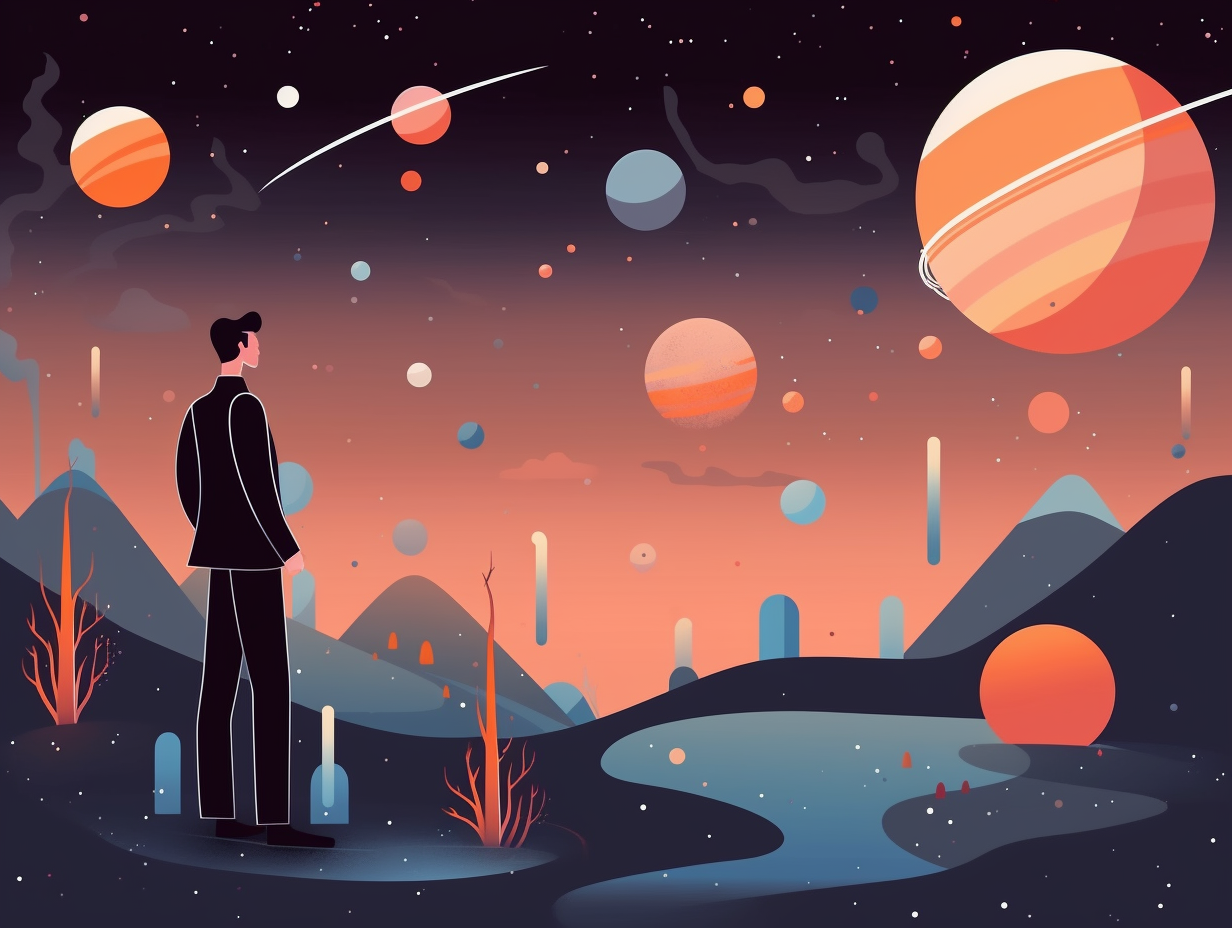Discover the Wonders: 14 Amazing Jupiter Fun Facts for Kids to Explore!

1. Jupiter's 95 Moons and Counting
If planetary real estate was a thing, Jupiter would be winning by a landslide with its enormous collection of moons: Jupiter's got at least 95 moons, four of which are absolute giants known as the Galilean moons! Discovered by Galileo Galilei, these lunar heavyweights include the solar system's largest moon, Ganymede, who's so big, he makes planet Mercury look like a mere pebble.
Source => en.wikipedia.org
2. Spinning DJ Jupiter
Jupiter is like the ultimate DJ, spinning faster than any other planet in our cosmic party: A full rotation takes only about 9.5 hours, causing its equatorial cloud-tops to whizz around at a mind-boggling 28,000 miles per hour! But it's not the fastest dancer in the galaxy, as some asteroids and dwarf planets can actually out-spin the Jovian giant.
Source => psi.edu

Skate through the cosmos and discover Saturn's icy rings! Made of water ice particles and influenced by the gravity of its moons, these majestic rings are a sight to behold. Glide into the world of planetary wonders on your next cosmic expedition!
=> Fun Facts about Saturn
3. Jupiter's Gas Cocktail Armor
Did you know that Jupiter is basically the heavyweight champion of gases, throwing atmospheric punches like a cosmic Mike Tyson? Its swirling, stormy ensemble includes hydrogen, helium, and a spattering of other gases that make up its fierce yet mysterious armor: In all seriousness, Jupiter's atmosphere is mostly made up of hydrogen and helium, along with small amounts of ammonia, sulfur, methane, and water vapor. It is this elusive cocktail that NASA's Juno mission is trying to decode as it measures the amount of water in the atmosphere to uncover secrets about the formation of our solar system. And just so you know, Jupiter has no surface to land on – it ain't Earth, folks!
Source => space.com
4. Cosmic Casanova's Gravity Pull
Hold on to your space pants because Jupiter has a gravitational pull more charismatic than a cosmic Casanova: With a surface gravity 2.4 times that of Earth's, this giant gas ball dictates motion in our cosmic neighborhood, making your 100-pound Earth self a whopping 240-pound space stud on its surface!
Source => coolcosmos.ipac.caltech.edu

5. Undecided Jovian Waistline
Who knew Jupiter can't decide whether to slim down or bulk up, much like a celestial Ted from Accounting on his yearly rollercoaster of resolutions: Jupiter's rotation is so sped-up at just 9.8 hours per spin, that it's fatter in the middle and skinnier at the poles, making it an oblate spheroid with an equatorial diameter of 88,846 miles and a polar diameter of only 83,082 miles.
Source => space.com
6. Jupiter's Giant Gas Buffet
Jupiter: the cosmic gas giant that never passes up a buffet! It's swollen to an immense size, gobbling up hydrogen and helium like a hefty dinner: But wait, there's a tiny, solid core housed within, making up a modest 4% to 14% of the planet's total mass, quietly hiding amidst layers of liquid metallic hydrogen and molecular hydrogen.
Source => universetoday.com
7. Crimson Cotton Candy Storm
Jupiter's Great Red Spot is like a colossal cosmic cotton candy machine gone haywire, whipping winds around at breakneck speeds and swirling them into a gargantuan crimson storm: In reality, this massive storm boasts winds of up to 268 mph, rotating counterclockwise, and has been observed since 1831. As it continues to shrink and flake around the edges, experts speculate on its possible dissipation within 20 years, while others argue that it might be here to stay, interacting with other weather patterns on the gas giant.
Source => en.wikipedia.org
8. Jupiter, the Radio Star
Move over, Interstellar DJs, there's a new radio star in town: Jupiter belts out more radio waves than any other object in the solar system, except the Sun, thanks to its atmospheric antics and the electric charms of its moon, Io.
Source => airandspace.si.edu
9. Home is a Storm Twice Earth's Size
You know what they say, home is where the largest storm in the solar system is: Jupiter's Great Red Spot is actually a ginormous anticyclone with a history of raging for at least 350 years, and it's twice as wide as Earth! Unlike our little holiday hurricanes, this mega-storm rotates anti-clockwise and scientists are still scratching their heads trying to figure out its secret to staying alive.
Source => mps.mpg.de

10. Mega-Moon Ganymede
Ready for a moon that's out of this world? Ganymede's got Mercury feeling small and wishing it could be a planet on steroids: This Jupiter-sized moon is the largest in our Solar System, boasting a diameter of 5,268 km (3,273.4 mi) and one-upping Mercury in size, while also rocking its very own magnetic field.
Source => universetoday.com
11. Jupiter's Dusty Rings
While Saturn's ring game is stronger than Beyoncé's, Jupiter rings a different bell altogether: Jupiter's lesser-known rings are made of dust grains, and it turns out, its very own Galilean moons are the culprits for preventing it from flaunting an even more fabulous ring system to outshine Saturn's glitzy icy loops.
Source => universetoday.com
12. The Ultimate Gravitational Bouncer
Who said size doesn't matter? Turns out, Jupiter's got some serious gravitational pull: This massive planet can not only deflect many comets and asteroids from crashing into Earth, but also send some hurtling towards us – both protecting and endangering our little blue home. Thanks to Jupiter, we might have the water and ingredients for life, but hey, remember the dinosaurs? One too many "Jovian gifts" and we could end up in the same boat (or crater) they did!
Source => missionjuno.swri.edu
13. Europa's Epic Pool Party
Europa's ocean throws the ultimate pool party – just BYOT (bring your own tidal heating)! Deep beneath this icy moon's surface, there's a real splash zone: Europa, a moon of Jupiter, has a subsurface ocean estimated to be 60 to 100 kilometers deep – much deeper than Earth's oceans. Largely kept liquid by tidal heating and an eccentric orbit, this salty pool party may have started thanks to Voyager and Galileo images revealing a chaotic terrain on Europa's surface.
Source => en.wikipedia.org
14. Galileo's Cosmic Quartet Discovery
Before Jupiter got into the moon-catching business: In 1610, Italian smarty pants Galileo Galilei caught sight of four celestial satellites, now known as the Galilean Moons, orbiting the gas giant through his homemade telescope. Named Io, Europa, Ganymede, and Callisto, this cosmic quartet shook up our understanding of the universe and helped modern astronomy level up.
Source => education.nationalgeographic.org
Related Fun Facts




















